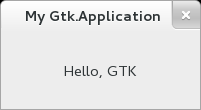Application is a class that handles many important aspects of a GTK+ application in a convenient fashion,
without enforcing a one-size-fits-all application model.
Currently, GtkApplication handles GTK+ initialization, application uniqueness, session management, provides some basic scriptability and
desktop shell integration by exporting actions and menus and manages a list of toplevel windows whose life-cycle is automatically tied to
the life-cycle of your application.
While GtkApplication works fine with plain Windows, it is recommended to use it together with
ApplicationWindow.
When GDK threads are enabled, GtkApplication will acquire the GDK lock when invoking actions that arrive from other processes. The GDK
lock is not touched for local action invocations. In order to have actions invoked in a predictable context it is therefore recommended
that the GDK lock be held while invoking actions locally with activate_action. The same applies to
actions associated with ApplicationWindow and to the “activate” and “open”
Application methods.
Automatic resources
Application will automatically load menus from the Builder
resource located at "gtk/menus.ui", relative to the application's resource base path (see set_resource_base_path
). The menu with the ID "app-menu" is taken as the application's app menu and the menu with the ID "menubar" is taken as the
application's menubar. Additional menus (most interesting submenus) can be named and accessed via
get_menu_by_id which allows for dynamic population of a part of the menu
structure.
If the resources "gtk/menus-appmenu.ui" or "gtk/menus-traditional.ui" are present then these files will be used in preference, depending
on the value of prefers_app_menu. If the resource "gtk/menus-common.ui"
is present it will be loaded as well. This is useful for storing items that are referenced from both "gtk/menus-appmenu.ui" and
"gtk/menus-traditional.ui".
It is also possible to provide the menus manually using set_app_menu and
set_menubar.
Application will also automatically setup an icon search path for the default icon theme by appending "icons"
to the resource base path. This allows your application to easily store its icons as resources. See
add_resource_path for more information.
If there is a resource located at "gtk/help-overlay.ui" which defines a ShortcutsWindow
with ID "help_overlay" then GtkApplication associates an instance of this shortcuts window with each
ApplicationWindow and sets up keyboard accelerators (Control-F1 and Control-?) to
open it. To create a menu item that displays the shortcuts window, associate the item with the action win.show-help-overlay.
A simple application
A simple example
GtkApplication optionally registers with a session manager of the users session (if you set the
register_session property) and offers various functionality related
to the session life-cycle.
An application can block various ways to end the session with the inhibit
function. Typical use cases for this kind of inhibiting are long-running, uninterruptible operations, such as burning a CD or performing a
disk backup. The session manager may not honor the inhibitor, but it can be expected to inform the user about the negative consequences
of ending the session while inhibitors are present.
See Also
HowDoI: Using GtkApplication,
Getting Started with GTK+: Basics
Example: Application:

public class MyApplication : Gtk.Application {
public MyApplication () {
Object(application_id: "testing.my.application",
flags: ApplicationFlags.FLAGS_NONE);
}
protected override void activate () {
// Create the window of this application and show it
Gtk.ApplicationWindow window = new Gtk.ApplicationWindow (this);
window.set_default_size (400, 400);
window.title = "My Gtk.Application";
Gtk.Label label = new Gtk.Label ("Hello, GTK");
window.add (label);
window.show_all ();
}
public static int main (string[] args) {
MyApplication app = new MyApplication ();
return app.run (args);
}
}
valac --pkg gtk+-3.0 Gtk.Application.vala
